
|
You entered: rocket
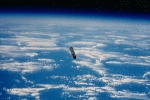 Tanks for the Lift
Tanks for the Lift
24.02.1996
Sixteen minutes after the liftoff of STS-29, the Space Shuttle Discovery's jettisoned External Tank (ET) is seen here, in a photograph by shuttle astronaut James P. Bagian, falling back towards Earth. The 154 foot long ET is the largest non-reusable component in the Shuttle system.
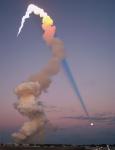 Shuttle Plume Shadow Points to Moon
Shuttle Plume Shadow Points to Moon
3.06.2007
Why would the shadow of a space shuttle launch plume point toward the Moon? In early 2001 during a launch of Atlantis, the Sun, Earth, Moon, and rocket were all properly aligned for this photogenic coincidence.
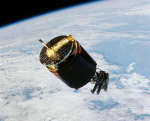 The Astronaut Who Captured a Satellite
The Astronaut Who Captured a Satellite
11.01.2010
In 1984, high above the Earth's surface, an astronaut captured a satellite. It was the second satellite captured that mission. Pictured above, astronaut Dale A. Gardner flies free using the Manned Maneuvering Unit and begins to attach a control device dubbed the Stinger to the rotating Westar 6 satellite.
 Shuttle Plume Shadow Points to Moon
Shuttle Plume Shadow Points to Moon
19.02.2001
Why would the shadow of a space shuttle launch plume point toward the Moon? Two weeks ago during the launch of Atlantis, the Sun, Earth, Moon, and rocket were all properly aligned for this photogenic coincidence.
 JWST: Ghosts and Mirrors
JWST: Ghosts and Mirrors
18.03.2017
Ghosts aren't actually hovering over the James Webb Space Telescope. But the lights are out as it stands with gold tinted mirror segments and support structures folded in Goddard Space Flight Center's Spacecraft Systems Development and Integration Facility clean room.
 Odysseus on the Moon
Odysseus on the Moon
2.03.2024
Methalox rocket engine firing, Odysseus' landing legs absorb first contact with the lunar surface in this wide-angle snapshot from a camera on board the robotic Intuitive Machines Nova-C moon lander. Following the landing on February 22, broken landing legs, visible in the image, ultimately left the lander at rest but tilted.
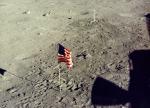 Footprints on Another World
Footprints on Another World
20.07.2002
On July 20th, 1969, humans first set foot on the Moon. Taken from a window of their Apollo 11 lunar module, the Eagle, this picture shows the footprints in the powdery lunar soil made by astronauts Neil Armstrong and Buzz Aldrin.
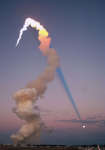 Shuttle Plume Shadow Points to the Moon
Shuttle Plume Shadow Points to the Moon
27.11.2011
Why would the shadow of a space shuttle launch plume point toward the Moon? In early 2001 during a launch of Atlantis, the Sun, Earth, Moon, and rocket were all properly aligned for this photogenic coincidence.
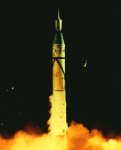 The First Explorer
The First Explorer
18.05.1997
The first US spacecraft was Explorer 1. The cylindrical 30 pound satellite was launched (above) as the fourth stage of a Jupiter-C rocket (a modified US Army Redstone ballistic missile) and achieved orbit on January 31, 1958.
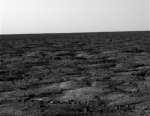 A New Horizon for Phoenix
A New Horizon for Phoenix
26.05.2008
This flat horizon stretches across the red planet as seen by the Phoenix spacecraft after yesterday's landing on Mars. Touching down shortly after 7:30pm Eastern Time, Phoenix made the first successful soft landing on Mars, using rockets to control its final speed, since the Viking landers in 1976.
|
January February March April |
|||||||||||||||||||||||||||||||||||||||||||||||||